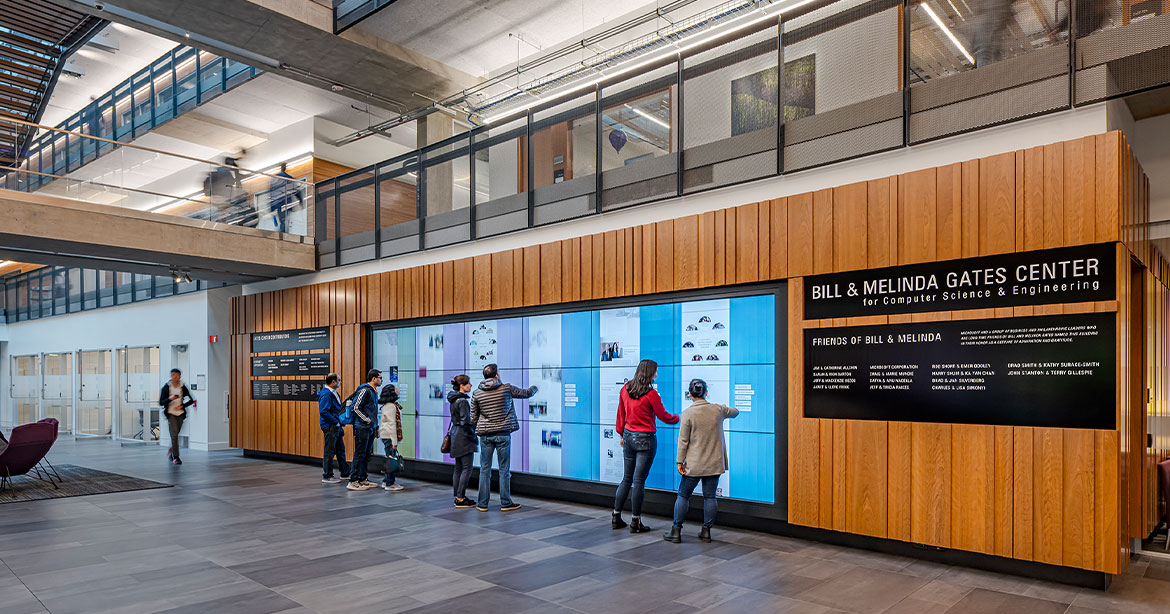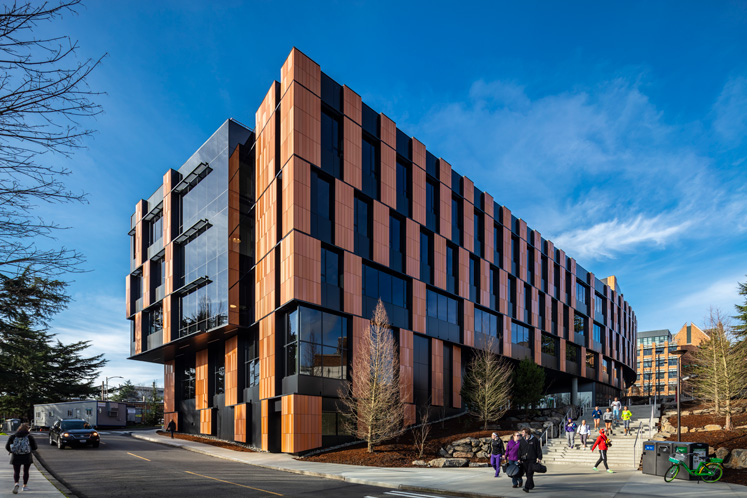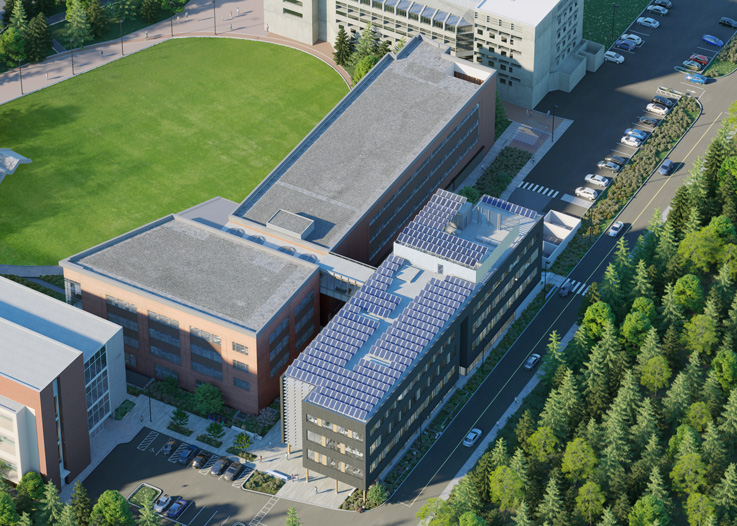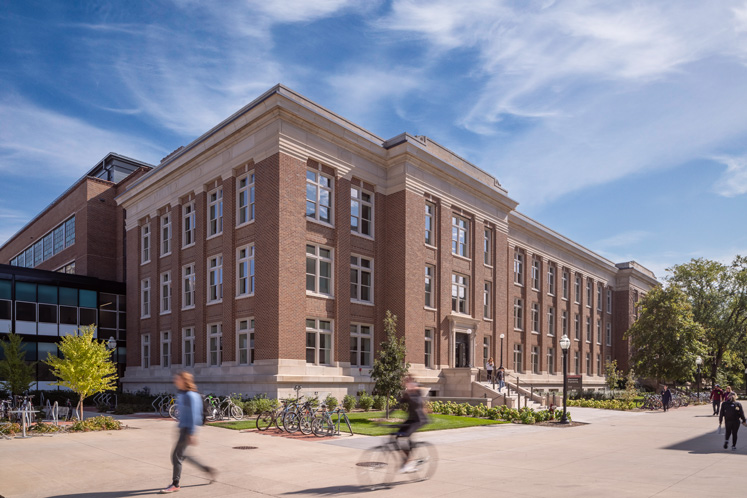
Time to read: 4 minutes, 34 seconds
Engineering is a popular and varied discipline with a promising career outlook. According to the U.S. Bureau of Labor Statistics, occupations in this industry are expected to grow 4% between 2021 and 2031, resulting in approximately 91,300 new jobs.
Attracting and retaining students for engineering programs remains competitive. Investing in building and renovating iconic university buildings is driven by the need to stay relevant in a rapidly evolving technological landscape, foster collaboration between academia and industry, and prepare graduates for the demands of the modern workforce.
“Colleges and universities face the constant challenge of declining enrollment and increased competition in recruiting students,” says Joanna Slominski, market director. “Investing in new and upgraded facilities, advanced lab spaces, and cutting-edge technology demonstrates a commitment to helping students learn and succeed. These spaces create a modern, collaborative learning environment tailored to the needs of engineering program students.”
Creating New Spaces for Collegiate Engineering Program Expansion
As programmatic demand outgrows current capacities, higher educational institutions face the challenge of supporting and servicing a larger student body.
Mortenson built the University of Washington’s Bill & Melinda Gates Center for Computer Science & Engineering to support program expansion for the Paul G. Allen School of Computer Science & Engineering.

(top) The Bill & Melinda Gates Center for Computer Science & Engineering at the University of Washington in Seattle. (lower left) The building’s atrium creates a warm and welcoming environment for students. (lower right) Students work in one of the new laboratory spaces outfitted with the latest research equipment and technology.
The 136,000-square-foot facility provides enough space for the program to double its annual degree production and helped the University recruit highly sought-after professors. Mortenson worked closely with the customer and design team to help ensure the right amount of focus was placed on instructional and collaborative spaces, a wet lab for molecular information system research, an innovative robotics lab, a 250-seat auditorium, and a flexible event space. Some classroom spaces were also designed to meet the specific needs of individual engineering professors. A bright, open atrium provides ample communal seating to foster a learning environment fueled by collaboration and innovation.
Western Washington University’s Kaiser Borsari Hall will bring new and old together to support the expansion of the University’s electrical and computer engineering, energy science, and computer science building.

Rendering of the future Kaiser Borsari Hall at Western Washington University. Image credit Perkins & Will.
The new four-story, 54,000-square-foot facility will house enhanced electrical engineering labs, active learning classrooms, collaboration space, and administrative space. A new sky bridge will connect Kaiser Borsari Hall to an existing Communications Building where Mortenson is also renovating a 20,000-square-foot space. Together, these spaces will create the highly collaborative environment students want, along with providing modern classrooms and technology to inspire innovation and help drive engineering programs into the future.
The University has set goals for Net Zero Energy and Net Zero Carbon campus. To help meet these goals, the new building features sustainably harvested wood glulam beams and columns with cross-laminated timber (CLT) components. The building will also have efficient mechanical and electrical systems, primarily powered by photovoltaic solar panels across the roof. These sustainability initiatives will make Kaiser Borsari Hall the first carbon-neutral collegiate facility in Washington.
Renovating Existing Campus Buildings to Accommodate Student Needs
Historic building preservation is an important part of any higher education construction plan. Program expansion presents an opportunity to perform necessary infrastructure upgrades and bring new amenities and technology into classrooms and common areas.
The University of Minnesota’s historic Mechanical Engineering Building needed mechanical and plumbing upgrades and an overall refresh to modernize the interior. After securing funding through a preservation and restoration program, the University contracted with Mortenson for a three-phase building renovation project.

(top) The historic Mechanical Engineering Building at the University of Minnesota, Twin Cities. (bottom left) A student works in one of the new engineering spaces. (bottom right) The renovation modernized common areas and upgraded the building’s infrastructure.
The first stage involved replacing a freight elevator and upgrading restrooms to bring the building to modern standards. Upgrades also involved installing new power and data systems to support growing demands for research and classroom activities.
The second stage of the project involved renovating the existing lab spaces and remodeling outdated floor plans to increase workflow efficiency among users. This phase of the project also included a modernized machine shop with the latest, industry-leading equipment.
Phase three involved renovating the existing classrooms and HVAC systems in the west wing of the building. Improvements included upgraded learning spaces and the addition of multiple remote learning classrooms, which was hugely beneficial during the COVID-19 pandemic.
Phasing the renovations ensured students and faculty had usable space throughout construction. However, completely gutting and remodeling each floor of an active campus building came with challenges.
Much of the work occurred while the building was occupied and operational, requiring careful disruption avoidance planning throughout the project. The team had to communicate regularly with the University to plan construction schedules around finals week, classroom schedules, and university events to maintain construction progress and limit the impact on space users. Efforts included detailed utility mapping to help minimize shutdowns in adjacent spaces. Additionally, the project team used HEPA filters and enclosures to significantly reduce construction dust. Through ongoing, proactive communication, the team helped minimize the impact of construction on adjacent learning spaces.
Engineering programs are important for colleges and universities due to their role in driving innovation, economic growth, and addressing societal challenges. To attract students and provide them with the tools they need to succeed, institutions should focus on iconic university buildings that pair modern amenities and technology with spaces that inspire innovative thinking. Explore more tips for successful higher education planning.



